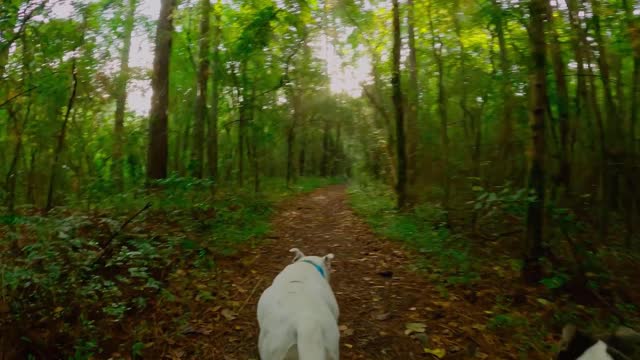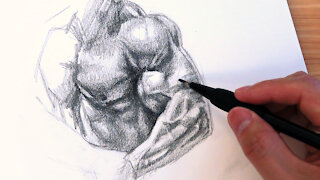Premium Only Content

Evolution of facial muscle anatomy in dogs.
Evolution of facial muscle anatomy in dogs.
Dogs have been shaped during the course of domestication both in their behavior and in their anatomical features. Here we show that domestication transformed the facial muscle anatomy of dogs specifically for facial communication with humans. A muscle responsible for the intense elevation of the inner eyebrow is uniformly present in dogs, but not in wolves. Behavioral data show that dogs also produce the eyebrow movement significantly more frequently and with greater intensity than wolves, with higher intensity movements produced exclusively by dogs. Interestingly, this movement enhances pedomorphism and resembles an expression that humans produce when they are sad, so its production in dogs may trigger a caring response. Our hypothesis is that the expressive eyebrows of dogs are the result of selection based on the preferences of humans.
Domestication turned wolves into dogs and transformed both their behavior and their anatomy. Here we show that in just 33,000 years, domestication transformed the facial muscle anatomy of dogs specifically for facial communication with humans.
Behavioral data, collected from dogs and wolves, show that dogs produce eyebrow movement significantly more frequently and with greater intensity than wolves, with higher intensity movements produced exclusively by dogs. Interestingly, this movement enhances pedomorphism and resembles an expression that humans produce when they are sad, so its production in dogs may trigger a nurturing response in humans.
The dog-human bond is unique and diagnostic of the evolution of human cultures. Dogs were domesticated more than 33,000 years ago, and during this period, selection processes have shaped their anatomy and behavior and made them man's best friend. Most notable among dogs' behavioral adaptations, as a result of selection during domestication, is their ability to read and use human communication in a way that other animals cannot . Dogs are more adept at using human communicative cues, such as pointing gestures or gaze direction, even than the closest living relative of humans, chimpanzees, and also than their closest living relatives, wolves or other domesticated species . Recent research suggests that eye contact between humans and dogs is crucial for dog-human social interaction. Dogs, but not wolves, establish eye contact with humans when they cannot solve a problem on their own . Eye contact also helps dogs know when communication is relevant and directed at them, because dogs tend to ignore human pointing gestures when human eyes are not visible . Dogs, but not wolves, seem to be motivated to make eye contact with humans from a young age , and dogs' motivation to make eye contact with humans seems to be an indicator of the level of attachment between humans and dogs . Thus, the mutual gaze between dogs and humans seems to be a mark of the unique relationship between both species during human cultural evolution.
They showed that between dogs and humans (but not wolves and humans), mutual gaze seems to lead to an oxytocin feedback loop analogous to that between human mothers and infants. Oxytocin plays a key role during affiliation behaviors in mammals and during the onset of maternal behavior and mother-infant attachment . Similarly, mutual gaze between dogs and humans seems to trigger an increase in oxytocin in both species, which increases the motivation to make eye contact . Since this cross-species oxytocin loop can be found in dogs and humans, but not between dogs' closest living relative (the wolf) and humans, selection processes during domestication must have played an important role in which dogs hijacked the human grooming response . The most likely evolutionary scenario is that the ancestor of dogs must have, to some extent, expressed traits that elicited a caring response from humans. Humans then consciously or unconsciously favored and therefore selected for these features, leading to the analogous adaptations we see in dogs today.
-
 23:18
23:18
Art of Wei
3 years agoHow to Draw and Shade Muscle Anatomy
33 -
 1:27:34
1:27:34
TruthStream with Joe and Scott
3 days agoArchitect Richard Gage: 911 truths and more #482
11.4K3 -
 3:47:17
3:47:17
The Pascal Show
18 hours ago $1.47 earnedBREAKING! Mass Shooting At Annunciation Church In Minneapolis Multiple Shot
21.5K7 -
 LIVE
LIVE
Lofi Girl
2 years agoSynthwave Radio 🌌 - beats to chill/game to
204 watching -
 2:02:49
2:02:49
Inverted World Live
9 hours agoAnnunciation Catholic School Shooting and Spiritual Warfare w/ AK Kamara | Ep. 99
199K27 -
 10:10
10:10
Robbi On The Record
3 days agoHollywood’s Hidden Messages: Predictive Programming & What’s Next
29K34 -
 4:43:34
4:43:34
Drew Hernandez
13 hours agoLGBTQ TERRORIST EXECUTES CATHOLIC KIDS IN MINNEAPOLIS
25.4K18 -
 2:17:08
2:17:08
FreshandFit
9 hours ago10 Top Red Pills About American Women
59.1K19 -
 2:10:26
2:10:26
Badlands Media
14 hours agoDevolution Power Hour Ep. 384: Durham’s Blind Spots, Soros Panic, and Trump’s Economic Warfare
74.1K36 -
 3:17:28
3:17:28
TimcastIRL
9 hours agoTrans Shooter Targets Catholic Kids In Mass Shooting, Leftists Reject Prayers | Timcast IRL
238K72